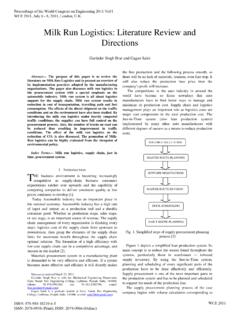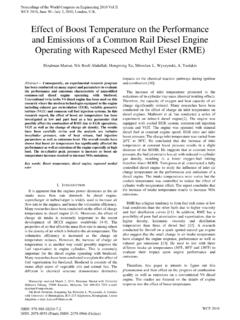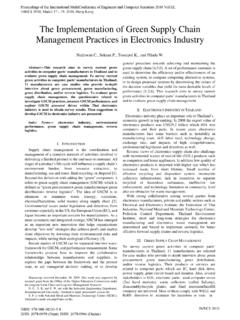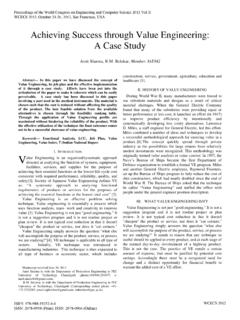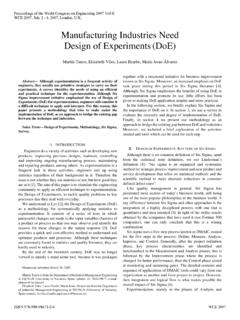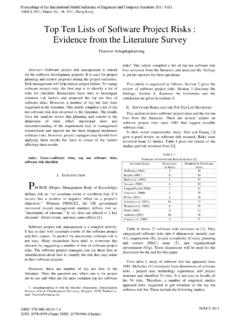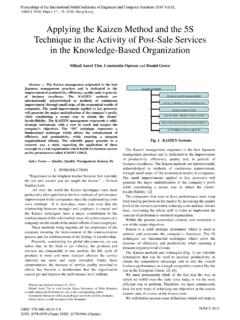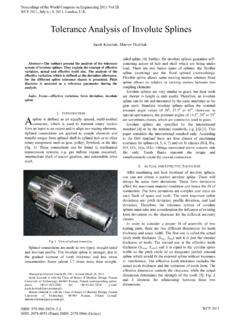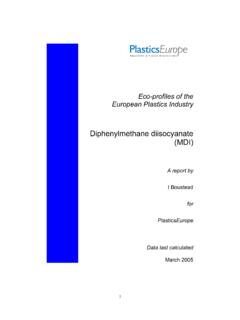Transcription of The Role of Trace Elements on Anaerobic Co …
1 Abstract In this study, we investigated the concentration of Trace Elements in the digestates in a laboratory batch Anaerobic digester. Many of these Trace Elements are important macro and micro nutrients. The availability of these nutrients for microbes responsible for Anaerobic digestion and substrate toxicity have to be controlled in biogas production. The analyzed substrates were characterized at various concentrations in the following Trace Elements ; potassium, phosphorus, manganese, copper, calcium, molybdenum, zinc, cobalt, iron, aluminum, silver, nickel and cadmium. Trace Elements like copper, silver, nickel, cadmium, zinc have been reported to be inhibitory and toxic under certain conditions in biochemical reaction depending on their concentrations.
2 These Trace Elements lower biogas production above threshold concentration due to accumulation of organic acid as a result of methanogenic bacterial inhibition. There was no deficit of nutrients detected in the Anaerobic digesters analysis. Keywords Anaerobic digestion, Co-digestion, Mesophilic Temperature, Trace Elements Manuscript received April 13, 2016; revised April 2016. This work was supported in part by University of Johannesburg, Process Energy Environmental station (PEETS) and City of Johannesburg South Africa. Anthony Njuguna Matheri; is with Department of Chemical Engineering; University of Johannesburg; Doornfortein, Johannesburg 2028 South Africa; Cell: +27616986335 Mohamed Belaid; Senior lecturer and HOD at Department of Chemical Engineering; University of Johannesburg; Doornfortein, Johannesburg 2028 South Africa; Tel: +27115596402 Tumisang Seodigeng; Senior lecturer at Department of Chemical Engineering; Vaal University of Technology; Private Bag X021-Vanderbijilpark-1911, Andries Potgieter Blvd South Africa; Tel: +27169509734 Jane Catherine Ngila; Professor and HOD at Department of Analytical Chemistry.
3 University of Johannesburg; Box 17011, Doornfortein, Johannesburg 2028 South Africa; Tel: 27115596169 ( I. INTRODUCTION HE economic development of developed and developing countries depend on the large extent on power generation. With the fast depletion of the scarce non-renewable energy sources such as fossil fuel and coal which has led to human health problems, environmental degradation and major factor of the global climate change scenario, the commercial production of biogas and other alternative energy sources such as solar energy, wind energy, hydropower, geothermal will definitely give a good drive for the development of the economy. Biogas is used in the form of fuel, electricity and heat.)
4 It is desirable to create a sustainable world class energy system which has zero carbon emissions [1-3]. Biomass fermentation increases biogas demand as a renewable energy and resolves waste management problems. The most popular types of substrates are animal manure, food waste, municipal sewage sludge, vegetable, fruit waste and municipal solid waste. Municipal solid waste, food waste and vegetable/fruit waste generate more methane compared to municipal sewage sludge and animal waste thus the need for co-digestion to increase efficiency of biogas production [4]. There is high increasing energy crops use as substrate in biogas production which run into deficit Trace Elements with regards to manures from cattle, chicken or pig.
5 However, variety of organic waste such as food waste, abattoir waste, kitchen waste are assumed to supply sufficient concentration and quantities of micro nutrients [5]. The co-digestion of manures and other substrates increase carbon to nitrogen (C/N) ratio and concentration of micro and macro nutrients that leads to increase in biogas production [6-8]. Biogas is a mixture of gases such as methane, carbon dioxide, hydrogen sulphide, ammonia and Trace amounts of oxygen, carbon monoxide and hydrogen. It is produced by break down of organic materials using microbial under controlled conditions (parameters). The organic source is composed of biodegradables such as municipal solid waste, agricultural waste, industrial waste and animal waste [9, 10].
6 Anaerobic digestion of organic material takes place in series of four fundamentals steps: hydrolysis, acidogenesis, acetogenesis and methanogenesis. Fig. 1 shows degradation steps of Anaerobic digestion process. In hydrolysis step, large organic polymers such as fats, proteins and carbohydrates are broken into fatty acids, amino acids and simple sugar respectively. This step is carried out by bactericides. The Role of Trace Elements on Anaerobic Co-digestion in Biogas Production Anthony Njuguna Matheri1, Member, IAENG, Mohamed Belaid2, Member, IAENG, Tumisang Seodigeng3, Jane Catherine Ngila4 T Proceedings of the World Congress on Engineering 2016 Vol II WCE 2016, June 29 - July 1, 2016, London, : 978-988-14048-0-0 ISSN: 2078-0958 (Print); ISSN: 2078-0966 (Online)WCE 2016 Hydrolysis is followed by acidogenesis where low alcohol and organic acids are produced through fermentation process utilized by fermentative bacteria.
7 This includes volatile fatty acids (acetic acid, butyric acid and propionic acid), gases like carbon dioxide, ammonia and hydrogen and aldehydes. In the third step (acetogenesis), the products of acidogenesis are converted to acetate, carbon dioxide and hydrogen by acetogenic bacteria. Methanogenesis is the final stage whereby methanogenes bacteria converts hydrogen, acetic acid and carbon dioxide to methane and carbon dioxide [11-13]. LCFAA cetogenesisAminoAcidsCarbohydratesHydrol ysisAcetateHydrogen and Carbon dioxideElectron Sinks , Ethanol, Butyrate and PropionateMethaneand Carbon dioxideOrganicPolymers(Cellulose, starch, protein, lipids etc.)AcidogenesisMethanogenesis Fig.
8 1. Degradation steps of Anaerobic digestion process. The effective production of biogas requires optimal: temperature, partial pressure, pH, hydraulic retention time, nature of substrate, C/N ratio, stirring intensity, Trace Elements concentration, microbes balance and digester size [4, 14]. Methane formation by methanogens is the necessary process stage because the bacteria responsible for the process are inhibited by their own products [15]. Biogas yield is determined by the content of micro and macro Elements which are responsible of methanogenesis and metabolic processes. Trace Elements can be inhibitory, stimulatory or even toxic in the digestates depending on the concentration [13, 16, 17].
9 These co-factors in enzymes decompose larger organics to smaller molecules [4]. The most important Trace Elements in micro nutrients mostly involved in Anaerobic digestion efficiency are cobalt, nickel, molybdenum and selenium. These Elements are always supplied with feedstock and their deficiency leads to poor performance of Anaerobic digestion [3, 5]. The investigated micro nutrients composed of zinc, molybdenum, manganese, copper, nickel and cobalt. The macro nutrients composed of potassium, calcium and iron were investigated. The negative influence of Trace Elements is determined by concentration in the substrate and pH of digestates.
10 The fermentation under presence of Trace Elements are effective under high pH [4, 18, 19]. Toxic Elements such as cadmium, phosphorus, chromium and lead can reduce efficiency and amount of methane formation. Toxic effect of Trace metals is mostly attributed by replacing naturally occurring Elements with enzyme prosthetic groups or due to disruption of enzyme function and restructure by bindings of Trace metals with thiols and other groups on protein molecules [18]. Selected Elements that speed up metabolism of biogas formation include potassium, calcium, magnesium, zinc, iron, zinc, cobalt and copper, but their concentration cannot exceed the threshold standards [4].
